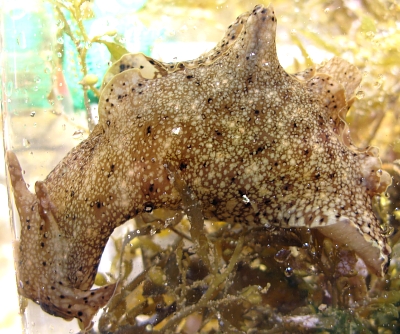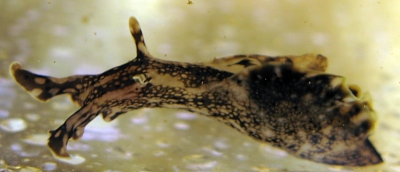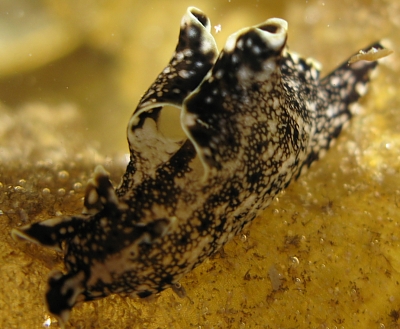Feeding studies on Aplysia in Malaysia
June 15, 2007
From: Corvin Eidens


Hello,
I am a graduate student, currently working for my master thesis about light stress and chemical defense in seaweed on the east coast of Malaysian peninsula. Because of induced chemical defense I need to have grazers in the tanks were I keep the algae. We really had problems to find grazers but luckily there are a lot of Aplysia sp. which are feeding on Laurencia. The problem is, that I do not know anything about these slugs but I really would like to!
The other thing is that we have to run our study with different species of algae but it is hard to get some here on the east coast. We now found some Padina sp. and I would like to know if Aplysia will feed on different algae? In the sea slug forum I read that Aplysia does not feed on encrusting algae ...
I have had some of the slugs in tanks with Aplysia and Padina for almost two weeks now and they are still alive!
The animal in the upper photo I have now had in a tank with Sargassum, while the two small ones are in the tank with Padina. When we collected them they had almost all the same colour (bright with some red). We now have around 100! Do they change colour because of camouflage reasons or because of UV-radiation?
I put two with a small piece of Padina in one tank and will check if they feed on the alga. Do you know how long they can survive without food? From which parts I need to take a close-up picture for identification?
Thank You so much for helping me! Here at the University nobody knows anything about Aplysia.
Best wishes,
Corvin
eidcor@web.de
Eidens, C., 2007 (Jun 15) Feeding studies on Aplysia in Malaysia . [Message in] Sea Slug Forum. Australian Museum, Sydney. Available from http://www.seaslugforum.net/find/20022
Dear Corvin,
You don't mention a size, but it looks as though the upper animal is quite a bit larger than the ones in the lower two photos. My guess is that they are all Aplysia oculifera, which usually has a pattern of small dark brown rings. In your animals they are not clear, but seem to be there.
Sea Hares usually feed on particular species of green and red algae and quite a few feed on species of Laurencia. I am not sure if you will have much luck with them eating brown algae. Species which produce purple ink, lose the ability if they are starved of red algae. Work that has been done on larval settlement shows that metabolites in certain algae trigger larval settlement. Fortunately A. oculifera has been extensively studied Itai Plaut [see message #2444 for references]. For further information on sea hares go to the General Topics list, where there is Sea Hares link which will take you to links to a list of sea hare feeding references and another on chemical defence.
Concerning the identification of sea hares, I am afraid it is often not easy. Although most species are quite easy to distinguish from other species when you see them alive, it is sometimes difficult to put a name on them, as many species were described from preserved animals. The only comprehensive review of species worldwide was based on preserved specimens and although the author noted the importance of colour and shape of living animals in naming new species, she proceeded to name quite a few more from decolourised preserved animals (Eales, 1960). All I can say is that as well as the colour pattern, you need to look at the general shape of the animal, size of the parapodia, whether they are joined at the back, whether there is a hole in the mantle through which the shell can be seen etc. Have a look at the pages on sea hares in the forum for background information.
However since your main interest is the algae, you probably don't want to get too involved in 'do it yourself'' slug identifications. You mention colour change. If you look at earlier messages on A. oculifera your will see some have a reddish background colour, while some which have been feeding on green Enteromorpha are quite green. It seems that pigments from the food they are currently eating can temporarily modify the colour of the sea hares.
As to them feeding on brown algae, I suspect they won't but I guess it's worth a try. How long can they starve? I am not sure, but as they tend to feed whenever food is present, I would think you would know after a week if they were not going to eat your Padina
Best wishes,
Bill Rudman
Related messages
-
Aplysia oculifera from Kerala, India
From: Dr. A. Biju Kumar, September 7, 2009 -
Aplysia? from Ratnagiri, India
From: Vishal J. Bhave., March 11, 2009 -
Aplysia kurodai ? in Indonesia
From: Teresa Zuberbühler, July 3, 2008 -
Re: Feeding studies on Aplysia in Malaysia
From: Corvin Eidens, July 21, 2007 -
Re: Feeding studies on Aplysia in Malaysia
From: Corvin Eidens, June 29, 2007 -
Aplysia oculifera eating Enteromorpha
From: Philibert Bidgrain, November 21, 2006 -
Upset Sea Hare in Sth Africa
From: Sakkie du Preez, April 26, 2006 -
Aplysia oculifera laying eggs
From: Dong Bum Koh, May 14, 2005 -
Aplysia oculifera from Sth Korea
From: Dong Bum Koh, May 14, 2005 -
Mating Aplysia oculifera from Sth Korea
From: Dong Bum Koh, May 14, 2005 -
Aplysia oculifera from the Philippines
From: Erwin Koehler, June 3, 2003 -
Aplysia from Chek Jawa, Singapore
From: Ria Tan, February 3, 2003 -
Aplysia oculifera from Japan.
From: Jun Imamoto, December 22, 2001 -
Happy to see an Aplysia forum
From: Itai Plaut, May 26, 2000
